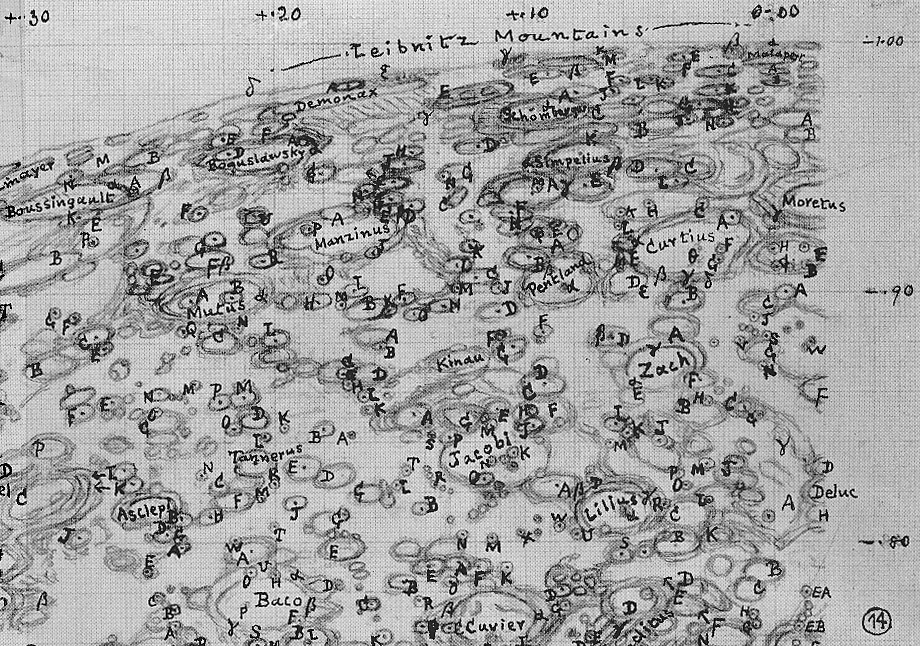Difference between revisions of "July 25, 2009"
(Created page with "__NOTOC__ =A Tangled Tale of Good Intentions= <!-- ws:start:WikiTextHeadingRule:2:<h1> --> <!-- ws:start:WikiTextLocalImageRule:8:<img src="/file/view/LPOD-Ju...") |
|||
| Line 6: | Line 6: | ||
<em>image from [http://the-moon.wikispaces.com/Wesley+and+Blagg+Maps the Moon-Wiki]</em><br /> | <em>image from [http://the-moon.wikispaces.com/Wesley+and+Blagg+Maps the Moon-Wiki]</em><br /> | ||
<br /> | <br /> | ||
| − | Do you lack basic drafting skills? So did Mary Blagg back in the 1930s, but she penciled the official lunar map for the International Astronomical Union that was the last graphical word on lunar nomenclature until the mid-1960s when the [mailto:tychocrater@yahoo.com Chuck Wood]</em><br /> | + | Do you lack basic drafting skills? So did Mary Blagg back in the 1930s, but she penciled the official lunar map for the International Astronomical Union that was the last graphical word on lunar nomenclature until the mid-1960s when the [http://www.lpod.org/?m=20071205 System of Lunar Craters] officially replaced it. Miss Blagg, as she was always referred to, was an indefatigable lunar nomenclature researcher. She had worked diligently to [http://the-moon.wikispaces.com/Collated+List identify and resolve differences] in names and letters given on different maps by 19th century lunar authorities, and the publication in 1935 of the <em>[http://the-moon.wikispaces.com/Named+Lunar+Formations Named Lunar Formations]</em> catalog and maps memorialized the sanity she brought to a confused situation. But as this excerpt of one the the NLF maps shows the maps she made were in some places difficult to decipher. This occasional ambiguity led those of us ([http://www.lpod.org/?page_id=1112 Dai Arthur], myself and other measuring assistants) compiling the <em>System of Lunar Craters</em> to sometimes abolish a NLF letter designation or more commonly to move it to a more conspicuous crater. Our decisions were based on the photographs of the <em>Photographic Lunar Atlas</em> of 1960, which was a vastly better resource than Miss Blagg had available. But those photographs were later supplanted by the far better vertical views of nearly the entire lunar surface by Lunar Orbiter IV, which Leif Andersson and I used to lead the recataloging and remapping of the nearside. Unfortunately, I went to Africa and Leif later died and the catalog and maps were never published in their entirety. Much of the date was published by Andersson and Whitaker in the [http://the-moon.wikispaces.com/NASA+RP-1097 NASA Catalogue of Lunar Nomenclature], but the maps were lost. This latter catalog was the basis for the current lunar nomenclature, augmented with new names and some corrections, that appears on the USGS's [http://the-moon.wikispaces.com/USGS+Digital+Atlas Digital Atlas of the Moon]. This document is the first (mostly) unambiguous nomenclature map of the Moon ever published. <br /> |
| + | <br /> | ||
| + | <em>[mailto:tychocrater@yahoo.com Chuck Wood]</em><br /> | ||
<br /> | <br /> | ||
<strong>Related Links</strong><br /> | <strong>Related Links</strong><br /> | ||
Revision as of 20:43, 1 January 2015
A Tangled Tale of Good Intentions

image from the Moon-Wiki
Do you lack basic drafting skills? So did Mary Blagg back in the 1930s, but she penciled the official lunar map for the International Astronomical Union that was the last graphical word on lunar nomenclature until the mid-1960s when the System of Lunar Craters officially replaced it. Miss Blagg, as she was always referred to, was an indefatigable lunar nomenclature researcher. She had worked diligently to identify and resolve differences in names and letters given on different maps by 19th century lunar authorities, and the publication in 1935 of the Named Lunar Formations catalog and maps memorialized the sanity she brought to a confused situation. But as this excerpt of one the the NLF maps shows the maps she made were in some places difficult to decipher. This occasional ambiguity led those of us (Dai Arthur, myself and other measuring assistants) compiling the System of Lunar Craters to sometimes abolish a NLF letter designation or more commonly to move it to a more conspicuous crater. Our decisions were based on the photographs of the Photographic Lunar Atlas of 1960, which was a vastly better resource than Miss Blagg had available. But those photographs were later supplanted by the far better vertical views of nearly the entire lunar surface by Lunar Orbiter IV, which Leif Andersson and I used to lead the recataloging and remapping of the nearside. Unfortunately, I went to Africa and Leif later died and the catalog and maps were never published in their entirety. Much of the date was published by Andersson and Whitaker in the NASA Catalogue of Lunar Nomenclature, but the maps were lost. This latter catalog was the basis for the current lunar nomenclature, augmented with new names and some corrections, that appears on the USGS's Digital Atlas of the Moon. This document is the first (mostly) unambiguous nomenclature map of the Moon ever published.
Chuck Wood
Related Links
Rükl plate 74
COMMENTS?
Click on this icon File:PostIcon.jpg at the upper right to post a comment.



